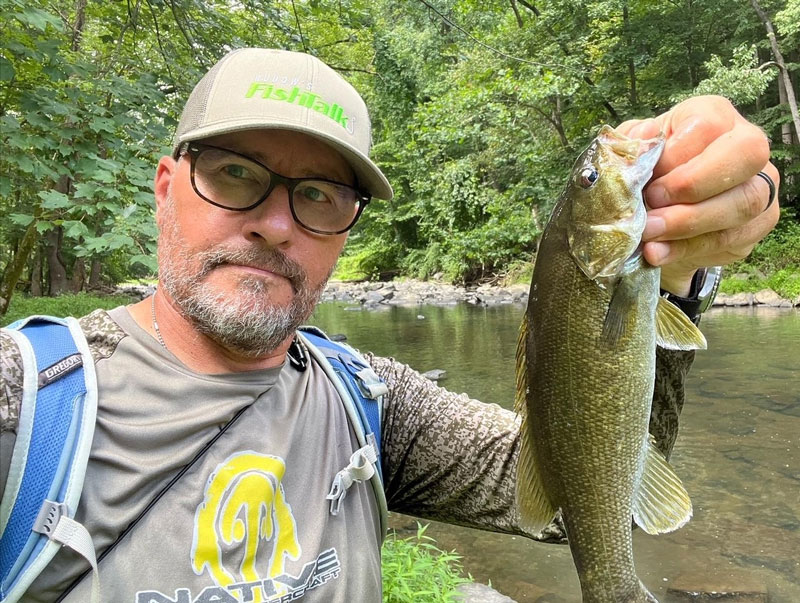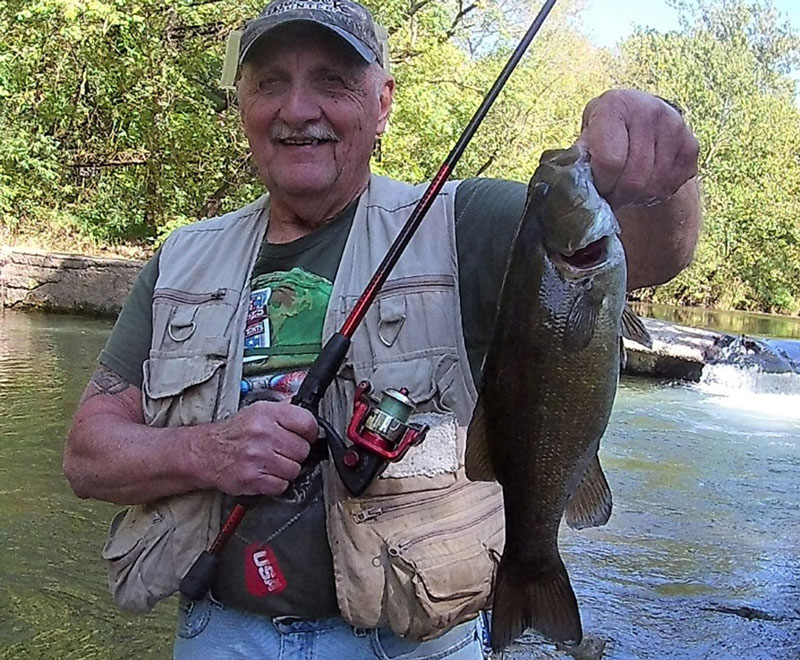Excellent fishing for smallmouth bass in an excellent reason to live somewhere, yet historians tell us that cities often grow up near a river’s fall line, where the piedmont meets coastal plains. Here, they say, a river’s first set of rapids is commonly encountered and this is the point at which easily navigating a boat upstream ends. Thus, those historians claim, the city’s founders would have stopped, unloaded, and set up camp. Balderdash! We anglers know better. In fact, the settlers stopped there because the changing geography meant tidal and non-tidal fisheries were both close at hand — a critical matter when choosing a location to live along a river prior to the invention of outboard engines.

As a result of the great and wise angling foresight of our forebearers, on the northern or western side of most of the major cities located on Chesapeake tributaries there’s some excellent freshwater river fishing. Just a few miles outside of Baltimore, the Patapsco awaits. The Potomac offers incredible potential even as it runs into the nation’s capital. The same is true of the James and its feeder creeks as they stretch towards Richmond. And among the species swimming in these waters is one of the most prized river-runners of all: the smallmouth bass.
Pound for pound, riverine smallmouth can kick a largemouth’s sweet patootie. They strike with aggression, tug like few fish can, go airborne with regularity, and use the river currents to their advantage so they feel twice as big as they actually are. True, river smallies are generally smaller than those slackwater bass, but they punch well above their weight. So, how will you hook into these near-city slickers? These five tricks will help.
Crazy Over Crayfish
Smallmouth absolutely love crayfish, perhaps more than any other potential meal. And in the same waters these fish live it’s incredibly easy to catch your own bait. Simply wade into ankle- to knee-deep water, roll over a rock, and have a dip net at the ready. When you spot a crayfish — sometimes you’ll see them scoot away as you roll the rock and other times they’ll sit motionless and hope their camouflage prevents detection — sit the net against the bottom a foot or two behind the critter. Then move a stick or a toe towards the crayfish until it shoots backwards and into the net.
Crayfish can be fished in a number of ways. You can put a hook in through the bottom of the tail and out through the back to be live-lined, fish them on a bare jig head hooked the same way and bounced along the bottom, or suspend one under a bobber and drift it through holes and along shorelines. Remember that when fished live and on bottom crayfish have a habit of crawling under rocks in their attempts to hide, and may need to be dislodged every few minutes or the fish won’t find them.
Very large mini-lobster can be tough for the fish to eat, but you can rip the tail off and it often proves as effective as a whole live crayfish. Using the tail alone is also a good move in areas where the fish are generally on the small side, or if you want to catch rock bass, bluegill, and other smaller species.
Get a Little Wee Craw
You’ll notice it’s rare we display tunnel-vision-level bias towards any one specific brand and model of lure; whether we’re talking topwater or jig tails, we usually offer at least two or three recommendations in the same breath. In this case, however, we can’t think of a single lure that matches up with the Rebel Wee Craw.
If you plan to target smallmouth in rivers, this lure belongs in your tacklebox — period. The Wee Craw is very small (just two inches) and works best with very light gear. It’s most effective in relatively small waterways and dives to four to six feet, but rarely snags when banging against rocks. Most of the smallmouth you’ll catch on it will be 18 or fewer inches, but you’ll discover it catches a shocking number of them, even when the fish seem disinclined to bite anything else.
In larger waterways when chasing bigger fish, you can upsize to the 2.75-inch Big Craw, which dives to eight to 10 feet. And in rivers you can practically hop across (yes, they do sometimes hold smallies), you can downsize to the 1.5-inch Teeny Wee. But for all-around smallmouth-catching utility, the Wee Craw will often prove to be just unbeatable. Don’t take our words for it. Get one and try it for yourself, and we bet you’ll never go smallmouth fishing without one again.
Catching Smallmouth Bass with the Hangy-Hangy
This simple tactic can be deadly in high-current areas, where there are boulders or holes the fish often hide near. After identifying a likely-looking spot, rig up a floating lipped diving plug with plenty of swimming action. Then, you’ll need to maneuver yourself into an up-current position. This is best done as much as possible from land versus wading, because anytime you wade you’re likely to muddy the waters a bit and disturb good spots located downstream. When a likely looking spot is right up against shore, ideally, you’ll be able to do the Hangy-Hangy while standing on shore or perched atop a rock or boulder not far from it.

Once you’re in position toss the lure downstream and leave your reel in freespool. Allow the current to take the lure back until it’s just short of the target zone, then close the reel. Now, you can point your rod left or right, and as the lure swims in the current it will work its way in one direction or the other. Once you’ve fine-tuned the lure’s lateral movement so it’s directly upstream of the target, open your reel again and allow the plug to float up to the surface, then float back in the current until it’s right on target. Close the reel again, and let that wiggler swim in the current right where you believe the fish to be.
If the expected smashing strike doesn’t materialize, try maneuvering the lure around in different positions by moving your rod right or left, dropping the lure back a bit more, or pulling it forward some. And if the strike still doesn’t come, start looking around for another target.
Use a Ned Rig
When the fish aren’t acting aggressive and it’s tough to get a bite, try dropping a Ned rig into deepwater holes. Although the plastic worm doesn’t really match up with any of the smallmouth’s favorite snacks, for some reason when they seem to be off their feed they’ll still hit a slow-moving worm. Two notes of caution: first off, come to grips with the fact that you’re about to snag and lose a few rigs. It’s the cost of doing business when you’re fishing a weighted lure dead on bottom in the riverine environment. Second, remember that the fish, which aren’t acting very aggressive in the first place, will probably hit with little more than a gentle slurp. So you need to be on a hook-setting hair trigger to make this tactic work.
Bladebaits for Smallmouth
One of the issues with any form of river fishing is rainfall and water clarity. In the days following a big storm it’s likely that some areas will be cloudy, and others may be downright unfishable. Most of the time, however, you can still get the fish biting. In some cases slightly off-color water can even produce better than gin-clear conditions will. And the ticket to triggering those off-color strikes will sometimes be tossing a lure with vibration-creating blades.
There are a huge number of bladed baits, ranging from inline spinners to spinnerbaits to tail spinners. All can work, with a few details taken into consideration:
- The cloudier the water, the darker a blade you’ll want. In clear water silver is usually best, in slightly off-color water gold is good, and in very off-color water copper or bronze can be the ticket.
- Generally speaking, the rounder the blade is the more vibrations it throws off. Long, slender blades create less vibration (and less resistance) while spinning. The lower visibility through the water is, the more you’ll want to “shout” at the fish by choosing blades that make the most vibrations possible.
- When the water is so muddy it appears virtually unfishable — but you still want to try and catch a fish — switch to a lure with matte painted blades in black or dark red. When visibility is near-zero, for whatever reason, dark matte blades like these can save the day.
Remember that for the vast majority of the anglers out there this is a catch-and-release game. Few people keep bass in the first place, and in Maryland both smallmouth and largemouth are closed to harvest from March 1 through June 15 while Pennsylvania holds the closure from April 8 through June 9 for spawning season. Different Virginia waterways have a number of different harvest restrictions and size or slot limits (visit the Virginia DWR website for the specifics). And Delaware has a no-take slot (12 to 17 inches with only one over 17 allowed). As always, we recommend checking your local regs before fishing because they can and do change from time to time.
Okay: Are you ready to leave the city behind, make a quick trip to the west or north, and enjoy some red-hot river action? You can do it tomorrow — and you have the fishing foresight of those wise settlers to thank for it.